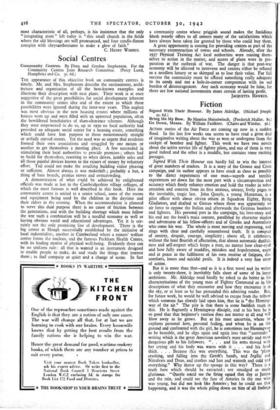Social Centres
Community Centres. By Flora and Gordon Stephenson. For the Community Centres Joint Research Committee. (Percy Lund, Humphries and Co. 31. 6d.)
THE appearance of this objective book on community centres is timely. Mr. and Mrs. Stephenson describe the environment, archi- tecture and organisation of all the best-known examples and illustrate their description with neat plans. Their work is at once suggestive of the great possibilities for social development inherent in the community centre idea and of the extent to which these possibilities were ignored during the inter-war years. This neglect was most obvious in the new housing estates where millions of houses went up and were filled with an uprooted population, oft= the bewildered beneficiaries of slum-clearance schemes. Although they were empowered to do so, up to 1930 no local authority had provided an adequate social centre for a housing estate, something which could have lent purpose to those monotonously straight or artfully curved streets. Yet the need was so urgent that residents formed their own associations and struggled by one means or another to get themselves a meeting place. A few succeeded in stimulating their local authorities to provide premises ; others had to build for themselves, resorting to whist drives, jumble sales and all those painful devices known to the raisers of money by voluntary effort. Toil could not make the resulting building either pleasing or sufficient. Almost always it was makeshift ; probably a hut, a thing of bare boards, primus stoves and overcrowding.
A demonstration of what could be achieved by enlightened officials was made at last in the Cambridgeshire village colleges, of which the most famous is well described in this book. Here the community centre is united to a senior school, some of the rooms and equipment being used by the children in the daytime and their elders in the evening. When the accommodation is planned to serve this dual purpose there is no cause of friction between the generations, and with the building shortage which must follow the war such a combination will be a needful economy as well as having obvious social and educational advantages. Yet it is cer- tainly not the only promising line of development. There is the big centre at Slough successfully established by the initiative of local industrialists, another in Cumberland where a miners' welfare centre forms the nucleus, and the famous Peckham Health Centre, with its leading motive of physical well-being. Evidently there can be no uniform rule: all that is wanted is an instrument designed to enable people to make, do and study the things that interest them ; to find company or quiet and a change of scene. In fact a community centre whose priggish sound makes the fastidious blush merely offers to all corners many of the satisfactions which have always been taken for granted by those who could buy them.
A great opportunity is coming for providing centres as part of the necessary reconstruction of towns and schools. Already, after the 1937 Physical Training Act local authorities were rousing them- selves to action in the matter, and scores of plans were in pre- paration at the outbreak of war. The danger is that post-war economy will be allowed to intervene and centres either be refused as a needless luxury or so skimped as to lose their value. For full success the community must be offered something really adequate to its needs and not a hole-in-corner compromise with its sad burden of discourage:nent. Any such economy would be false, for there are few national investments more certain of lasting profit.
JACQUETTA HAWRES.


























 Previous page
Previous page